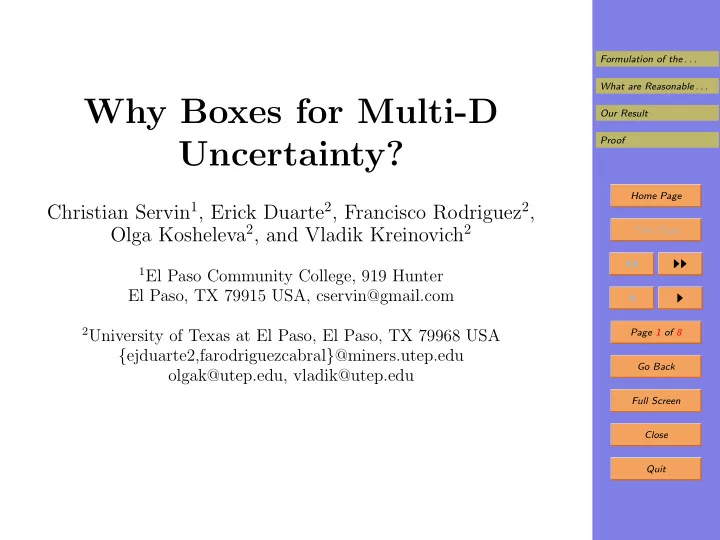

Formulation of the . . . What are Reasonable . . . Why Boxes for Multi-D Our Result Proof Uncertainty? Home Page Christian Servin 1 , Erick Duarte 2 , Francisco Rodriguez 2 , Olga Kosheleva 2 , and Vladik Kreinovich 2 Title Page ◭◭ ◮◮ 1 El Paso Community College, 919 Hunter El Paso, TX 79915 USA, cservin@gmail.com ◭ ◮ 2 University of Texas at El Paso, El Paso, TX 79968 USA Page 1 of 8 { ejduarte2,farodriguezcabral } @miners.utep.edu Go Back olgak@utep.edu, vladik@utep.edu Full Screen Close Quit
1. Formulation of the Problem Formulation of the . . . • In practice, we often do not have a complete informa- What are Reasonable . . . tion about the values of several quantities x 1 , . . . , x n . Our Result Proof • Thus, several possible tuples x = ( x 1 , . . . , x n ) are con- sistent with our knowledge. Home Page • How can we describe the set of possible values of x ? Title Page • In many practical applications,we get reasonable re- ◭◭ ◮◮ sults if we approximate this set by a box ◭ ◮ [ x 1 , x 1 ] × . . . × [ x n , x n ] . Page 2 of 8 • Why boxes? Why not other families of sets? Go Back Full Screen Close Quit
2. What are Reasonable Properties of the Corre- Formulation of the . . . sponding Family F of Approximating Sets? What are Reasonable . . . • Usually, we know some bounds on all x i , so each set S Our Result should be bounded. Proof • It is reasonable to require that each set S ∈ F is closed: Home Page indeed, Title Page – if a = lim a n for a n ∈ S , ◭◭ ◮◮ – then for any measurement accuracy, a is indistin- guishable from some some possible a n ∈ S , ◭ ◮ – thus, we will never be able to tell that a is not Page 3 of 8 possible. Go Back • Similarly, the family F should be closed. Full Screen Close Quit
3. Reasonable Properties (cont-d) Formulation of the . . . What are Reasonable . . . • Also, often, the observed tuple consists of two indepen- dent components x i = y i + z i ; so: Our Result Proof – if the set Y of all y ’s and the set Z of all z ’s are possible, Home Page def – then the set Y + Z = { y + z : y ∈ Y, z ∈ Z } is also Title Page possible; ◭◭ ◮◮ – this set is called the Minkowski sum . ◭ ◮ • So, F should be closed under Minkowski sum. Page 4 of 8 • Finally, the numerical values of each quantity x i change if we change the starting point and/or measuring unit: Go Back x i → a i + b i · x i . Full Screen Close • These changes do not change what is possible. Quit • So, F should be closed under these transformations.
4. Our Result Formulation of the . . . • Every family F that satisfies these properties contains What are Reasonable . . . all the boxes. Our Result Proof • Thus, the boxes form the simplest possible approxi- mating family. Home Page Title Page ◭◭ ◮◮ ◭ ◮ Page 5 of 8 Go Back Full Screen Close Quit
5. Proof Formulation of the . . . • For each set S , we can take: What are Reasonable . . . Our Result – first S 1 = S , Proof – then S k +1 = 0 . 5 · ( S k + S k ) for k = 0 , 1 , 2 , . . . • In the limit, we get a convex hull of S . Home Page • By appropriate re-scaling x i → b i · x i , we can shrink Title Page this set S in all directions except one i 0 . ◭◭ ◮◮ • In the limit, we get an interval parallel to the i 0 -th axis. ◭ ◮ • By shifting and re-scaling, we get all possible intervals Page 6 of 8 parallel to this axis. Go Back • We can thus have n intervals [ x i , x i ] each of which is: Full Screen – parallel to the i -th axis and Close – has all other coordinates 0s. Quit
6. Proof (cont-d) Formulation of the . . . • We can have n intervals What are Reasonable . . . Our Result [0 , 0] × . . . × [0 , 0] × [ x i , x i ] × [0 , 0] × . . . × [0 , 0] . Proof • The Minkowski sum of these intervals is the box Home Page [ x 1 , x 1 ] × . . . × [ x n , x n ] . Title Page • Thus, each family F satisfying the above properties ◭◭ ◮◮ contains all the boxes. ◭ ◮ • (Also, the class of all boxes satisfies all the above prop- Page 7 of 8 erties.) Go Back Full Screen Close Quit
Recommend
More recommend